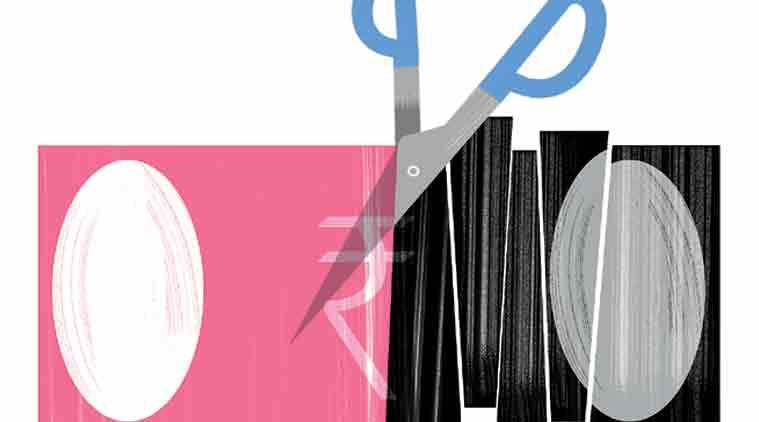 The government’s revenue and capital spending recorded a mixed trend during the lockdown months. (File)
The government’s revenue and capital spending recorded a mixed trend during the lockdown months. (File)
The spread of the COVID-19 pandemic, and various fiscal and other measures announced by the government to contain its impact, have structurally altered the arithmetic for its finances for the current fiscal year. While the fiscal outlook is evolving along with the pandemic and its economic fallout, the range of options suggests that the government’s fiscal deficit for 2020-21 could surge to anywhere between Rs 13-16.1 trillion, well above the budgeted level of Rs 8 trillion.
The data we have for the first two months of the current year is sobering. With a sharp squeeze in revenue receipts, amidst a marginal contraction in total spending, the Centre’s fiscal deficit has widened to Rs 4.7 trillion in April-May, stretching already to 59 per cent of the budget estimate (BE) — this is 27 per cent higher than the same period last year.
The government’s revenue and capital spending recorded a mixed trend during the lockdown months. After expanding by a sharp 24 per cent in April, partly reflecting up-fronting of some spending, revenue expenditure contracted by 26 per cent in May. In contrast, capital outlay, which had shrunk by 8 per cent in the first month of the lockdown, rose by a substantial 57 per cent as the lockdown restrictions were partly eased.
Encouragingly, the extent of contraction in the Centre’s gross tax revenues has narrowed down to 37 per cent in May, from 44 per cent in April, led by indirect taxes, as transactions have improved with the easing of restrictions. Reports have also pegged the decline in direct tax collections at about 25 per cent as on June 17 — in line with our GDP forecast for the first quarter.
On the indirect tax side, GST collections have recovered sharply, from 28 per cent in April (as compared to collections over the same period last year) to 91 per cent in June. However, the inflows in June include late payments for the previous three months as well and are therefore unlikely to be a good representation of the level of collections we should expect in the subsequent months. Data on e-way bills paints a similar picture. GST e-way bills, as a percentage of the levels observed last year have also risen, from a muted 16 per cent in April to 87 per cent in June. However, a note of caution — pent up demand, especially for items that are now considered to be essential under the work-from-home scenario, could have led to a temporary uptick in sales of small to mid-sized consumer durables in the initial “unlocking” period. While this would boost both e-way bills and GST collections, it may not sustain.
With these mixed trends, how do we foresee government finances unfolding over the year? Building in the expected impact of continuing economic uncertainty on individual and corporate income levels and non-discretionary spending, the windfall related to the hikes in excise duty levied on petrol and diesel, and adjusting for lower taxes to be devolved to the states, ICRA expects net tax revenues of the Centre to fall short of the budgeted level by Rs 3.9 trillion. Further, the current market conditions also indicate a shortfall of non-tax revenues from the telecom sector as well as disinvestment proceeds. We peg this gap at Rs 2.2-2.3 trillion.
The fiscal support announced by the government under the Aatmanirbhar Bharat Abhiyan is estimated at around Rs 2 trillion. At the same time, the expenditure management measures that had been put in place for the first quarter have now been extended to the second quarter. However, assessing the extent of savings that can be generated by such spending restrictions is challenging at this juncture. If we are to assume a moderate compression in expenditure, our baseline estimate is that the Centre’s fiscal deficit will surge to Rs 13 trillion this year.
However, a lack of clarity continues to persist on some big-ticket items. For instance, the provision of free foodgrains under the Pradhan Mantri Garib Kalyan Ann Yojana has been extended till November, at an aggregate cost of Rs 1.5 trillion. Our understanding is that only Rs 0.3 trillion towards such costs was included in the fiscal support announced earlier. If the balance amount is entirely funded through budgetary resources, as opposed to the possibility of being partly funded through loans from the National Small Savings Fund to the Food Corporation of India, then the government’s fiscal deficit would rise further to Rs 14.2 trillion.
It is also clear that the compensation that is to be provided to state governments will significantly overshoot the funds that will accrue through the compensation cess. We project the gap between the available past and current cess collections, and the requirement for compensation (for 2020-21 and what was pending for 2019-20 at the end of March), at a staggering Rs 3.9 trillion. If the Centre provides only half of these funds, its fiscal deficit would surge further by around Rs 2 trillion to nearly Rs 16.1 trillion. However, if the GST Council decides to, and is procedurally able to, borrow funds to compensate the states — backed by a guarantee from the Centre — its fiscal deficit and market borrowings would not be affected. Moreover, if the government decides to ramp up its capital spending later in the year to stimulate the economy, it could generate additional fiscal pressures.
Worryingly, the anticipated fiscal slippage, even in our base case scenario, exceeds the extent by which the Centre’s market borrowings have already been increased. However, amidst all these concerns, yields on government security appear remarkably sanguine, as if they are patiently waiting for the central bank to absorb the extra sovereign borrowings in the primary or secondary market.
The writer is principal economist, ICRA. Views are personal